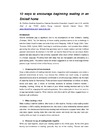| dc.contributor.creator | Gardiner-Hyland, Fiodhna | |
| dc.date.accessioned | 2018-02-22T11:30:02Z | |
| dc.date.available | 2018-02-22T11:30:02Z | |
| dc.date.issued | 2011 | |
| dc.identifier.citation | Gardiner-Hyland, Fiodhna. (2011). 10 ways to encourage beginning reading in an Emirati home. Read Magazine | en_US |
| dc.identifier.issn | 2221-3740 | |
| dc.identifier.uri | http://hdl.handle.net/10395/2150 | |
| dc.description | Originally published in issue 3 on pages 2 to 4 of Read Magazine | en_US |
| dc.description.abstract | Parents worldwide play a significant role in the development of their children’s reading (Trelease, 2006). Yet, the fostering of home reading practices seems to be a challenge in both the United Arab Emirates and wider Arab world (Mograby, 1999; Al Tanejji, 2001; TahaThomure, 2003; Hyland, 2003). Learning to read takes practice, more practice than children get during the school day. Schools that genuinely want to create readers can’t do it without parental involvement. As teachers in the UAE, we need to think of how we can ensure Arabic parents feel able enough to help at home, especially when much of their children’s reading is
in a foreign language. Providing them with ideas that are manageable and stimulating is a good starting point. This article makes ten simple suggestions on how to encourage Emirati parents to get involved in their child’s literacy at home. | en_US |
| dc.language.iso | eng | en_US |
| dc.publisher | International Printing Press | en_US |
| dc.relation.ispartofseries | Read Magazine; | |
| dc.subject | Children | en_US |
| dc.subject | Early reading | |
| dc.subject | Education | |
| dc.subject | Emirati | |
| dc.title | 10 ways to encourage beginning reading in an Emirati home | en_US |
| dc.type | Article | en_US |
| dc.type.supercollection | all_mic_research | en_US |
| dc.type.supercollection | mic_published_reviewed | en_US |
| dc.description.version | Yes | en_US |


